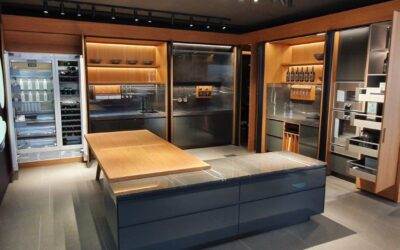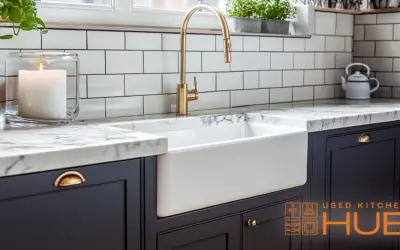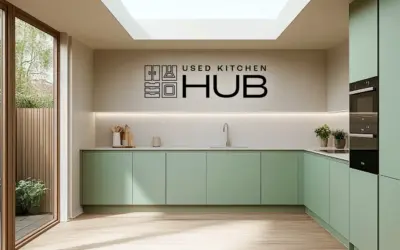Transform Your Kitchen for £6,000: A Smart Guide to Budget-Friendly Luxury
Introduction: Luxury on a Budget
Creating a beautiful kitchen doesn’t require breaking the bank. With thoughtful planning and strategic investments, you can transform your kitchen into a stunning space that combines functionality, aesthetics, and sustainability—all within a £6,000 budget.
As a family-run business committed to quality craftsmanship, we understand that every kitchen tells a story. Your renovation journey should reflect both your personal style and practical needs while being mindful of financial constraints. This guide will walk you through how to maximise your investment for a kitchen that feels premium without the premium price tag.
Disclaimer: Used Kitchen Hub doesn’t sell every product listed in this guide, such as flooring, but we do specialise in premium ex-display kitchens, cabinetry, and appliances from top luxury brands. By sourcing these high-value elements through our marketplace, you can complete a stunning kitchen renovation on a surprisingly low budget. This guide shows how to plan a transformation for around £6,000, with ex-display choices doing much of the heavy lifting.
Smart Planning: Your Foundation for Success
Successful kitchen renovations begin long before the first cabinet is removed. A well-structured plan serves as your roadmap throughout the process, helping you avoid costly mistakes and delays.
Assess Your Current Layout
Begin by thoroughly evaluating your existing kitchen:
- Which elements still function well and could be repurposed?
- What are your main pain points? (Insufficient storage, poor workflow, outdated appliances)
- Are there structural issues that need addressing?
- Which cosmetic changes would create the most significant impact?
Document your findings with photos and measurements. This assessment provides a clear starting point and helps identify priorities for your renovation.
Create a Realistic Timeline
Most budget-conscious kitchen renovations take 3-4 weeks, though projects without structural work can be completed within a week Consider:
- Demolition and preparation (2-3 days)
- Structural changes, if necessary (3-5 days)
- Plumbing and electrical work (2-3 days)
- Cabinet installation (3-5 days)
- Worktop installation (1-2 days)
- Appliance installation (1-2 days)
- Finishing touches (2-3 days)
Allow for a buffer of a few extra days to accommodate unexpected issues. Planning your timeline in advance helps coordinate tradespeople efficiently and minimises the period you’ll be without a functional kitchen.
Prioritise High-Impact Changes
When working with a defined budget, focus on changes that deliver maximum visual and functional impact:
- Cabinet refacing or repainting rather than full replacement where possible
- Updated hardware on existing cabinetry
- Strategic lighting improvements
- Statement backsplash in key areas
- Quality taps and fixtures as focal points
Consider Pre-Loved Luxury Elements
One of the most effective strategies for achieving a high-end look within budget is incorporating pre-loved luxury elements:
- Ex-display kitchen units from showrooms
- Gently used high-end appliances
- Reclaimed wood for character features
- Vintage fixtures that add unique charm
- Surplus stone or quartz from larger projects
These items often retain their quality and appearance while costing significantly less than new alternatives. Additionally, choosing pre-loved items reduces environmental impact, supporting a circular economy approach to home renovation.
Where to Invest Your £6,000 Budget
With an increased budget of £6,000, you have more flexibility to create a truly transformative kitchen renovation.
To note: This breakdown illustrates how a £6,000 renovation budget might be distributed across typical components. While Used Kitchen Hub doesn’t sell all these items individually, our marketplace helps you save significantly on the most expensive elements, making the rest of your budget go further.
Here’s a strategic breakdown of how to allocate your funds:
Quality Cabinetry (£2,300–2,800)
Cabinetry typically forms the largest portion of your budget and makes the most visible impact:
- Consider factory-assembled units for better quality control
- Explore ex-display kitchen units for significant savings on premium brands
- Invest in soft-close mechanisms for drawers and doors
- Focus on durability in high-use areas like around the sink and hob
- Mix open shelving with closed storage for visual interest and cost savings
With the additional budget, you can afford higher-quality door fronts, more drawers (which are typically more expensive than standard cabinets but offer better functionality), and potentially extend cabinetry to create more storage solutions.
Worktops (£1,000–1,500)
Worktops endure daily use and serve as a visual anchor for your kitchen:
- Quartz composite offers durability and low maintenance
- Butcher block provides warmth and can be more affordable
- Consider mixing materials—premium surfaces in high-visibility areas and more budget-friendly options elsewhere
- Look for remnant pieces of natural stone for significant savings
- Investigate engineered stone options that mimic premium materials
The increased budget allows for higher-quality materials or larger sections of premium surfaces, particularly around key areas like islands and preparation zones.
Essential Appliances (£1,500–1,800)
Strategic appliance choices balance performance with value:
- Invest in energy-efficient models that reduce long-term operational costs
- Consider ex-display or previous year’s models for significant savings
- Focus on the appliances you use most frequently
- Look for versatile options that serve multiple functions
- Research warranty and service availability before purchasing
With your expanded budget, consider upgrading to higher-efficiency models or adding specialty appliances that enhance your cooking experience.
Lighting and Hardware (£500–700)
These finishing touches dramatically impact both functionality and aesthetics:
- Layer lighting with a combination of task, ambient, and accent sources
- Upgrade to energy-efficient LED options
- Choose statement hardware that elevates standard cabinetry
- Install under-cabinet lighting for improved functionality
- Consider smart lighting solutions for enhanced convenience
Flooring (£500-800)
With the additional budget, you can now include flooring updates:
- Luxury vinyl tiles offer water resistance and durability at reasonable prices
- Engineered wood provides natural warmth with better moisture stability
- Ceramic or porcelain tiles offer long-lasting performance in various styles
- Consider refinishing existing hardwood floors rather than replacing them
Backsplash and Wall Treatments (£200-400)
An often overlooked area that can dramatically change your kitchen’s appearance:
- Ceramic subway tiles offer timeless appeal at accessible prices
- Glass mosaic accents create focal points without covering large areas
- Painted breadboard provides texture and character economically
- Consider extending your worktop material as a backsplash for a cohesive look
Sustainable Choices, Premium Results
Making environmentally conscious decisions doesn’t just benefit the planet—it often leads to unique, characterful kitchens with significant cost savings.
The Benefits of Pre-Loved Elements
- Access to premium materials and craftsmanship at reduced prices
- Unique character pieces that aren’t found in standard retail offerings
- Reduced environmental impact through reuse rather than new production
- Often higher-quality construction than similarly priced new items
- Supporting local businesses and craftspeople who specialize in restoration
Sustainable Material Selection
When selecting new materials, consider their environmental impact:
- FSC-certified wood products ensure responsible forestry practices
- Water-based paints and finishes reduce harmful VOCs
- Recycled glass countertops offer unique aesthetics with environmental benefits
- Cork or bamboo flooring provides renewable alternatives to hardwood
- Energy-efficient appliances reduce ongoing resource consumption
Upcycling Opportunities
With creativity, existing elements can be transformed:
- Refinish rather than replace solid wood cabinetry
- Update cabinet doors while maintaining functional boxes
- Repurpose furniture pieces as kitchen islands or storage
- Transform outdated appliances with specialty appliance paint
- Create feature pieces from reclaimed materials
Smart Renovation Strategies
DIY vs. Professional Work
Balancing professional expertise with DIY efforts can optimise your budget:
- Consider DIY for cosmetic updates like painting, hardware replacement, and simple backsplash installation
- Hire professionals for electrical work, plumbing, and structural changes to ensure safety and compliance
- Get multiple quotes for specialised work and check references thoroughly
- Consider hiring a kitchen designer for a few hours of consultation to optimise your layout
- Research thoroughly before attempting DIY projects to ensure you have the necessary skills and tools
Phased Implementation
If your budget is still tight, consider approaching your renovation in phases:
- Focus first on layout improvements and essential infrastructure
- Update cabinetry and storage solutions in the second phase
- Add premium finishes and decorative elements in the final phase
- Plan your phases to minimise redundant work and disruption
Hidden Cost Considerations
Be aware of potential unexpected expenses:
- Building permits and inspections (requirements vary by location)
- Waste removal and disposal fees
- Temporary kitchen setup during renovation
- Delivery charges and special installation requirements
- Correction of previously unknown issues (plumbing problems, electrical upgrades, etc.)
Setting aside 10-15% of your budget for contingencies helps manage these surprises without compromising your vision.
FAQs About Budget Kitchen Renovations
How can I stick to my £6,000 budget?
Create a detailed plan with itemised costs, prioritise essential upgrades, and consider pre-loved luxury items for significant savings without compromising quality. Track expenses diligently throughout the project and make decisions with your overall budget in mind rather than in isolation.
Where should I save vs. splurge?
Invest in foundational elements like cabinetry and worktops that would be expensive to replace later. Save on decorative items, hardware, and accessories that can be easily updated as your budget allows. Quality plumbing fixtures often provide good value as they combine high visual impact with functional importance.
What’s the typical timeline for a £6k renovation?
With proper planning, most budget-conscious renovations take 3-4 weeks to complete. This timeline allows for sequential work by different tradespeople and accounts for material delivery times. Careful coordination and advance ordering of materials can help minimize delays.
Should I hire professionals or DIY?
Consider a mixed approach: DIY for simple cosmetic changes but hire professionals for technical installations to ensure safety and longevity. Electrical work, plumbing modifications, and structural changes typically require professional expertise and may need to meet building regulations.
Which materials offer the best value?
Look for pre-loved premium materials that combine durability with style. Quality craftsmanship maintains its value and performance over time. Materials like quartz composite worktops, solid wood cabinetry, and high-grade stainless steel offer excellent longevity for your investment.
How can I make my kitchen appear more luxurious than my budget suggests?
Focus on a few strategic premium elements in highly visible areas. Quality lighting, statement hardware, and a carefully chosen backsplash can elevate the entire space. Consider investing in open shelving to display attractive kitchenware and create a custom look without the cost of additional cabinetry.
Conclusion: Creating Your Dream Kitchen Within Budget
Transforming your kitchen on a £6,000 budget doesn’t mean compromising on quality or style. With careful planning, strategic investments, and a focus on sustainability, you can create a space that balances beauty and functionality while maintaining the integrity of quality craftsmanship.
Remember that a successful renovation respects both your financial boundaries and your environmental values. By making thoughtful choices about where to invest and where to economise, you’ll create a kitchen that not only looks beautiful but also reflects your personal priorities and supports your lifestyle for years to come.
Whether you’re preparing family meals, entertaining friends, or simply enjoying your morning coffee, your renovated kitchen will provide both the practical functionality and aesthetic pleasure that makes this investment truly worthwhile.
This comprehensive guide has been created by our team of kitchen design specialists with over 15 years of experience in delivering beautiful, functional kitchens on modest budgets. We believe in empowering homeowners with the knowledge to make informed decisions that balance cost, quality, and sustainability.


